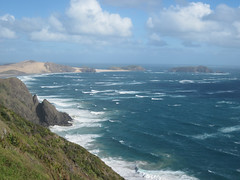After a ferry ride crossing the Hokianga Harbor to Kohukohu, we drove to Cape Reigna at the top of the North Island. This was a pilgrimage of sorts. We were looking for closure, symmetry. Having traveled to the most southerly point of the South Island, we were determined to have matched NZ’s topographic tips.
Miraculously, the rain stopped, and the day bloomed as sunny as it’d been for days. But never have either of us been so frightened by wind, except during tornado weather as a child where I grew up in Minnesota. The gusts had to be at least 60 mph, and nearly blew us off the cliff. Hunched like ancient scribes, we clutched side rails as we walked slowly and carefully down hill to the lighthouse.
Wowowowoowowow! Eerie and utterly breathtaking. We came, we saw … we were humbled by the sight of the two mighty oceans smashing into each other. It was like watching two worlds colliding.

Twelve degrees below the Tropic of Capricorn, the Columbia Basin Maelstrom off the coast of the Te Aupouri Peninsula produces a fiery of waves nearly 35 feet high. For Maori the swirling whirlpools, reminiscent of the wake of a waka (canoe), symbolizes the fusing of the male (Tasman) with the female (Pacific) and the creation of life.
Cape Reinga, “the place of the leaping,” is where the Maori believe the spirits of their dead begin passage to the afterlife. Legend has it they leap off the headland and descend to the underworld on steps created by the roots of an ancient pohutukawa tree. In this way, they journey back to their spiritual ancestral home of Hawaiki.
Named Te Aroha, the legendary tree clinging to a rock, did look old and scrawny from the viewing platform where we stood several hundred feet above. The photograph shows it as a mere speck. It’s thought to be about 800 years old. Unlike other pohutukawa, which blossom blood-red at Christmas time, this tree has never been known to flower.
On our drive back south, we stopped for a glimpse at Te Oneroa a Tohe, which is significant to the Maori as the “pathway of the spirits.” This gigantic sandscape is famed as the Ninety Mile Beach—no one seems to know why since it runs only 55 miles south from Cape Reinga). During peak season, the place is a magnet for tourist buses and sand boarders during peak season.
At the northern end, the beach is heaped by sand dunes up to four miles wide and 500 feet high, where we first accessed the beach at Te Paki, but left because we had absolutely no interest in trekking across four miles of drifting sand to the coast.
Farther south, we checked out the southern access late afternoon. It was monumental, empty, haunting. I will end with the words of poet Barry Mitclafe who described this beach: “as this good-for-nothing, going nowhere laze of a long beach at the edge of the world.”
Continue Northland: Old Bones of Trees and Rocks





